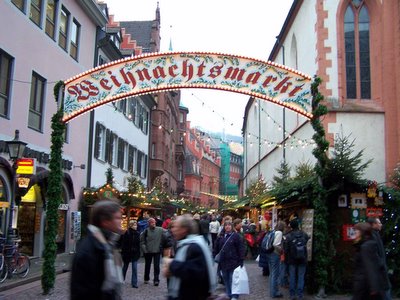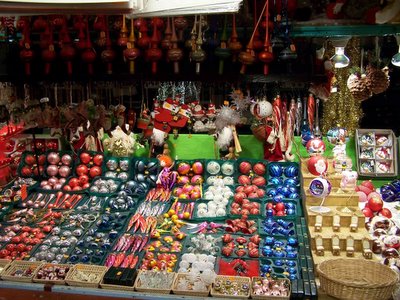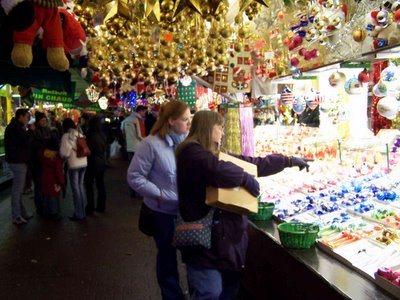
I've always been a sentimental sap for Christmas. More than any other holiday, Christmas is about connections with family and friends and heritage. Each and every year there are the rituals of gift giving and holiday dinners and cookies and tree decorating and kids and nieces and nephews and church going. The world can be pretty crazy and life can change pretty fast. But there is something in Christmas that provides security and comfort and stability.
Christmas this year is bittersweet. It is exciting to be in France and even better to have Amanda here visiting with us. However, there is an empty chair at the table where Jake should be sitting. We miss him a lot. We miss a lot of other people too.
There are a lot of things I could write about for Christmas. I could tell you about the Christmas dinners where all the expatriots get together. Or I could describe how crazy the shopping is on Christmas Eve. (Since everything is closed on Dec 25 and 26, there is a rush for bread and milk at the groceries.) Or I could tell you about the nice little gift exchange between Theresa, Amanda, and me.
This posting, however, will be about Midnight Mass in the Cathedral.
I'm not going to pretend to be pius or anything. An heaven knows I'm not the worlds most adherent Catholic. It's a purely selfish thing. No matter how much things differ between France and the USA, the mass is pretty much the same. Yes, the language is different ... but there is a rythym and musical quality that trascends everything else. Strasbourg or Rome or Greenwood or Evansville....it is all the same. You go to a Catholic mass anywhere in the world and you get the same product. I find great comfort in that.
And so, on Christmas Eve the streets of Strasbourg finally start to quiet down. The stalls of the Christmas Markets all close at 5 pm and the throngs of tourists finally disappear. The streets, though empty, are still quite bright from the Christmas lights that hang across from side to side.
The Rue Mercière runs right up the the front doors of the cathedral. It is beautifully lit with arches of lights with stars in the center of the street. The street roughly traces one of the old Roman roads that used that used to run through the village. The other main Roman road ran perpendicularly just behind what is now the cathedral. It was this confluence that eventually caused
Strasbourg to be named "Strasbourg" - the city of the roads.
At the time of the very first Christmas, there was supposedly a temple of Hercules where the cathedral now stands. A few centuries later, it was replaced by a Romanesque church and, sometime in the 1200's the construction of the present day cathedral was started. Viewed from the outside, the cathedral is stunning. The pink sandstone is carved so finely that it looks like lace. Moreover, the exterior is covered with allegorical statues that symbolize the stories of the bible, carved for the faithful in a time when literacy was rare.
The inside of the cathedral is, forgive me for being blunt, dark and drab. There is not a lot of ornament. An Italian or Spanish church would have an ornate high altar with paintings and gold leaf. Not so here. Where the high altar would stand, there is nothing but a simple cross. This Spartan furnishing is very much a result of what the history books call the "protestant reformation". In the years following Martin Luther there was bitter conflict in this area of Alsace, along with the other German principalities and the Netherlands and Switzerland. Much of the "idolatrous decoration" was, I believe, removed by the protestants in the periods when they held the cathedral.
The protestant vs. catholic violence continued up until the start of the 20th century. As a side note, it seems that the protestant sects fought pretty bitterly amongst themselves as well. So much so that a couple of small sects from the area - one led by a guy named Jacob Amman and the other led by a guy named Menno Simon - decided to pack up all their faithful followers and move to America. And so it goes that one group became the Amish and the other became the Mennonites. The locals tell me that the language of the Pennsylvania Dutch is really Alsacien. They loved the movie "Witness"with Harrison Ford. No subtitles needed for them to understand the Amish dialect.
But back to Midnight Mass.....
We arrived at the cathedral at about 11:30 or so. You have to enter through these small side doors. (I have never seen a cathedral open it's front main doors. They are just too large. Maybe 20 to 25 feet tall and 12 feet from side to side. ) The place was completely packed. There was a choir performance before the mass and we were hoping that perhaps some squatters would give up their seats when the mass started. It was a good strategy and, in the end, we all got seats.
The cathedral, which is usually very dark, was very brightly lit by stage lights. Perhaps this was for television. But with the lights I could make out details I'd never noticed before. For example, the ceilings showed traces of faded murals and in the vaulting, where the ribs come together, there were faces carved in the stone as if they are looking down from heaven.
The Archbishop of Strasbourg was the lead celebrant with 11 other priests assisting. The opening procession was a parade priests. But once started, it was the same Midnight mass you would get anywhere else in the world. Sure, it was in French, but it was still recognizable.
Notre Père qui es aux cieux, que ton nom soit sanctifié, que ton règne vienne, que ta volonté soit faite sur la terre comme au ciel.Donne-nous aujourd'hui notre pain de ce jour.Pardonne-nous nos offenses, comme nous pardonnons aussi à ceux qui nous ont offensés.Et ne nous soumets pas à la tentation, mais délivre-nous du Mal,
And, so as we are sitting there, it occurs to me that this same celebration has occurred every year in this same building for the past 700 years or so. That means that 700 years ago, the same carved faces in the vaulting were looking down on the poor townsfolks and peasants who, no doubt, were also standing in wait for a seat. Furthermore, if you allow for the earlier churches, it means that the same celebration has occurred in the same spot, more or less, for perhaps 1500 years.
There is a comfort in that. There is a permanence. It is comforting to know that the little dramas that seem so big in our lives are, in the scheme of things, just a small part of a larger story. 700 years ago the people standing for a seat were probably also worrying about their children.
The first reading was in French. The second reading was in German. The gospel was in French and German. This was very fitting for a Christmas in Alsace, where to this day people struggle to balance their German and French heritage. But it doesn't matter the language. You recognize the story.
Il y avait, dans cette même contrée, des bergers qui passaient dans les champs les veilles de la nuit pour garder leurs troupeaux. Et voici, un ange du Seigneur leur apparut, et la gloire du Seigneur resplendit autour d'eux.
Ils furent saisis d'une grande frayeur. Mais l'ange leur dit: Ne craignez point; car je vous annonce une bonne nouvelle, qui sera pour tout le peuple le sujet d'une grande joie: c'est qu'aujourd'hui, dans la ville de David, il vous est né un Sauveur, qui est le Christ, le Seigneur.
The sermon was in French, and it was a bit long. The archbishop had a captive audience and he was not going to pass up the chance. By Amanda's count, the sermon went on for about 40 minutes. She was bored. But I really liked the sermon.
The theme of the sermon was Christ as the bringer of peace. The archbishop started out with his take on the modern world and his opinion that we could certainly stand for a lot more peace in the world. I suppose this is true. Was there ever a time when it was not true?
Then he told a story as to how, when he was first named as Archbishop to Strasbourg, he made a call on one of the city fathers. This one in particular had been mayor after the war and later a representative to the European parliment. The old man told the Bishop that in his youth, he had seen French and Germans die by the hundreds, and then the thousands, and then the hundreds of thousands. There was not enough room in the world for all the sorrow. And then, with time, they learned to live in peace. So much peace had come that they all now come to celebrate midnight mass together. He said that in the past 65 years of his life he had seen a miracle.
And this got me to thinking....
I've always thought of miracles as things that happen instantaneously. Blind can see. Lame can walk. God snaps his fingers and things happen.
But really, the biggest miracles come not with the snap of a finger, but with the steady hand of God guiding things over time. I remember when my brother Bob was 10, I thought it would be a miracle if he lived to be 12. Now he is a grown man in his 40s with a beautiful family. If you knew him at 10, you would agree that this is a miracle. As another example, after 45 years, I still am blessed in this world with my parents and all my brothers and sisters. By any standard, this is a miracle. My own children are no longer children, but rather struggling toward adult lives of their own. There is much that is miraculous in this. There is much to be thankful for.
I suppose that miracles are not so rare as I once thought. In truth, each life is a miracle in the making. And I count myself blessed by all the miracles that are my family and Theresa's family.
Eventually, the bishop finished his sermon. Then came communion. (This was chaos. Even at church, Europeans do not know how to form a line.) Then the bishop and all the priests and altar-persons lined up for the recessional at the ending of the mass. Now, all of the music prior to that point had been a highly-polished production by the choir. The recessional hymn, though, was for everyone to join in. I knew the song well. Even though the words were strange, it was the same song that ended every midnight mass I'd ever been to.
Stille Nacht ! Heilige Nacht !
Alles schäft; einsam wacht
nur das traute, hochheilige Paar;
holder Knabe im lokkigen Haar,
schlaf in himmlischer Ruh,
schlaf in himmlischer Ruh.
I turned to follow the procession out and saw that they had opened the huge, main doors of the cathedral. Through the open doors you could see the lights of the Rue Mercière. There were arches of lights and stars and garland stretching out to the horizon. It was magic. It was as if all the roads of the world came together there and ran through the main doors and up the center aisle. That same road where Roman soldiers may have stopped one cold night to look up at a strange star in the southeast.
And I know too that the road runs the other way. It runs to Greenwood Indiana, and Evansville, and Florida, and North Dakota, and Ohio, and Texas. To all the places where my heart is. To all the places where miracles are in progress.
Merry Christmas to all of you, with love.











 Above, you see a picture of Strasbourg markets on a "slow day".
Above, you see a picture of Strasbourg markets on a "slow day".




 In the two photos above, you have the view from the ancient convent of Mont Saint Odile (
In the two photos above, you have the view from the ancient convent of Mont Saint Odile ( 

